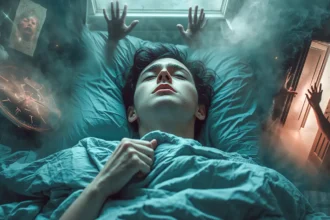The Fear That Won’t Let You Sleep
You’re running. Breathless. No one behind you, but something’s there. You wake up disoriented, drenched in adrenaline.
It wasn’t real, but your nervous system didn’t get the memo.
Nightmares about being chased aren’t just common. They’re persistent. They follow no logic, just raw panic. And the scariest part?
You almost never escape. You keep running. Night after night.
This isn’t random dream content. These chase nightmares are emotionally charged signals. Your subconscious is waving red flags while you sleep, using fear as language.
The question isn’t, “Why am I running?” It’s “What am I avoiding?”
Let’s decode the symbols. Unpack the fear. And figure out how to stop living your nights on the run.
The Psychology Behind Chase Nightmares
Chase dreams are your brain’s emotional escape room. They’re a survival script, not a horror film. Your mind stages symbolic danger to process unresolved tension, internal conflict, or unacknowledged stress.
The content is metaphor, not memory. The pursuer might represent a deadline, a mistake, a relationship, or a truth you won’t face. You run in the dream because you’re stuck in waking life.
“It’s VERY common to dream of being chased. In fact, it’s one of the most commonly recurring dreams.” (Lauri Loewenberg, Certified Dream Analyst, 2024)
If your body’s still wired from cortisol overload, or you’re in chronic avoidance mode, your REM cycle turns into a psychological treadmill. The result: recurring dreams where fear builds but never breaks.
Dreams don’t care if the threat is social or existential. They just amplify whatever’s unprocessed. When your brain can’t resolve something by day, it chases you at night.
To stop the loop, we need to understand what it’s showing us, and what it needs to end.
Why the Nightmare Keeps Coming Back
Chase dreams don’t just happen once. They return, often with minor changes, but the same emotional core. That’s because your brain isn’t finished.
It’s trying to process something you’re still pushing away.
Nightmares repeat when a fear stays unresolved. Each dream becomes an emotional simulation where the body re-experiences helplessness, stress, or panic. The brain is running a fear pattern, hoping you’ll notice, confront, or reframe it.
“These results suggested that the typical theme ‘being chased or pursued’ in dreams may represent some waking‑life experiences metaphorically.” (J. Wang et al., Dream‑Research Study, 2024)
If you keep avoiding a hard conversation, a personal truth, or even a decision, that avoidance becomes fuel. The brain doesn’t let go.
It stores the tension until REM sleep and then acts it out symbolically.
Whether it’s a vague threat or a specific person chasing you, the pattern reveals something persistent. Your subconscious doesn’t have language, it has symbols, conflict, repetition. Until something changes, it replays the story.
Dream of Being Chased compared to Dream of Falling, Falling Teeth, or Earthquake
| Aspect | Dream of Being Chased | Dream of Falling | Dream of Falling Teeth | Dream of Earthquake |
|---|---|---|---|---|
| Commonality | These nightmares are frequently reported by many individuals. | Falling dreams can evoke strong feelings of vulnerability. | Losing teeth often symbolizes anxiety about appearance. | Earthquake dreams may indicate feelings of instability. |
| Emotional Impact | The fear experienced can be intense and overwhelming. | Falling can create a sense of helplessness and fear. | Teeth falling can reflect concerns about aging or loss. | Earthquake dreams often evoke fear of chaos or change. |
| Symbolism | Chase dreams symbolize avoidance of unresolved issues. | Falling dreams may represent loss of control in life. | Teeth loss symbolizes anxiety about communication or self-image. | Earthquake dreams symbolize deep-seated fears of upheaval. |
| Frequency | These nightmares can occur frequently during stressful periods. | Falling dreams can happen during moments of anxiety. | Teeth dreams can occur sporadically, often linked to stress. | Earthquake dreams may happen during times of personal turmoil. |
| Resolution Techniques | Coping strategies include confronting underlying fears directly. | Techniques involve grounding exercises and mindfulness. | Addressing anxiety can help reduce occurrences of teeth dreams. | Practicing relaxation techniques may alleviate earthquake dreams. |
| Associated Fears | Common fears include failure, rejection, or confrontation. | Falling dreams often relate to fear of failure or inadequacy. | Teeth dreams may connect to fears of losing control. | Earthquake dreams can reflect fears of losing stability. |
This loop is rarely about nightmares alone. It’s about psychological stalling. The fear keeps chasing you because, emotionally, you’re standing still.
Until you face what’s metaphorically hunting you, your dream won’t stop running.
“The nightmare presents us, in the clearest form, what is present in all dreams. Thus, the nightmare is the most useful dream.” (Ernest Hartmann, M.D., Dream Researcher, 1999)
How to Interrupt the Nightmare Loop
You can’t stop fear from entering your dreams, but you can change how your brain processes it. The goal isn’t to erase dreams. It’s to end the cycle of emotional chasing without resolution.
First: journal the dream. As soon as you wake up, write everything. Who chased you. What terrain.
How you felt. This begins pattern recognition. Once your conscious mind names the fear, it softens.
Second: examine what you’re avoiding. Often the dream theme mirrors waking resistance. A person you won’t confront.
A truth you won’t face. Naming it lets the nightmare become a message, not a threat.
Third: practice pre-sleep imagery. Right before bed, rehearse a new ending. Imagine turning to face the pursuer.
Let the dream change. You’re not erasing fear. You’re teaching your brain a new response.
Last: improve sleep hygiene. Nightmares feed off emotional and physiological chaos. Fixing your bedtime, reducing screens, and lowering caffeine can shrink nightmare intensity, even before you touch the dream content.
This is how you stop dreaming like prey. You stop avoiding the fear, and start scripting a different role inside it.
What Each Coping Strategy Actually Solves
Different tools target different parts of the nightmare mechanism. The key is combining emotional insight with practical intervention. Here’s how common strategies break the chase cycle:
| Coping Tool | What It Actually Does |
|---|---|
| Dream journaling | Externalizes the fear script and tracks recurring themes |
| Pre-sleep visualization | Reprograms the chase dynamic with new emotional outcomes |
| Stress reduction in real life | Lowers emotional overload that leaks into REM nightmares |
| Cognitive behavioral therapy | Reframes avoidance patterns contributing to nightmare loops |
| Improved sleep hygiene | Regulates REM quality and limits night-time emotional chaos |
| Emotion-focused confrontation | Ends the loop by resolving the conflict behind the dream |
You don’t need all six. But two or three together, especially journaling and pre-sleep rehearsal, can shift the pattern fast.
These aren’t just dream hacks. They’re mental rewrites.
The goal isn’t to force peace. It’s to meet the fear in the dream, and stop running from yourself.
When You Should Consider Professional Help
Not every nightmare needs therapy. But if they’re chronic, distressing, or bleed into your waking mood, professional support is more than justified. Recurring dreams are signals, sometimes urgent ones, from your emotional architecture.
If you feel anxious before bed, dread sleeping, or wake with lingering fear or guilt, it’s not just “a bad dream.” It’s unprocessed emotion rerouting through sleep. Left unchecked, this can fuel anxiety or depression.
Therapies like Imagery Rehearsal Therapy (IRT) help rewire dream patterns directly. You rehearse new outcomes in waking life to change dream scripts. It’s clinically validated and especially effective for recurring nightmares and PTSD-related dreams.
CBT (Cognitive Behavioral Therapy) also reduces nightmare frequency by tackling the real-life stressors driving the content. When your baseline fear drops, your brain stops needing the same chase metaphor to process overload.
There’s no weakness in seeking help. You’re not “too sensitive” or broken. You’re just stuck in a loop your body can’t solve alone.
A therapist doesn’t erase the dreams, they teach your mind to resolve what they’re pointing at.
And that’s when the chasing stops.

Stop Running, Start Rewriting
Chase nightmares aren’t about monsters. They’re about momentum. Your psyche uses fear to force movement, but until that movement happens in real life, the dream keeps looping.
You can’t run forever.
Every repeated dream is unfinished business. The content changes slightly, but the structure is the same: threat, escape, no closure. That means your nervous system is waiting for you to make a new choice.
Ending the nightmare isn’t about silencing fear. It’s about listening to it, decoding its metaphors, and taking one action that breaks the emotional freeze-frame.
You don’t need full resolution. Just motion.
Write the dream down. Ask what you’re avoiding. Shift the ending.
Clean up your sleep. Face one thing you’ve been dodging. Your brain will notice.
Dreams adapt fast when reality changes.
This isn’t magic. It’s mechanics. Nightmares chase you because they’re built on what’s stuck. The moment you stop freezing or running, internally or externally, the loop breaks.
You’ve outrun the dream long enough. Time to walk toward what it’s showing you.
Further Reading
Nightmares and the Brain – Harvard Medical School, Harvard Health Publishing.
Explores the neuroscience behind nightmares, including how fear circuitry activates during sleep and impacts health.
https://hms.harvard.edu/news-events/publications-archive/brain/nightmares-brain (Harvard Medical School)
Imagery Rehearsal Therapy: Benefits for Nightmares – Healthline.
A clear overview of IRT, how rewriting nightmares can reduce their frequency and intensity and improve sleep.
https://www.healthline.com/health/sleep/imagery-rehearsal-therapy (Healthline)
Why You Keep Having Recurring Dreams – Sleep Foundation.
Explains how recurring nightmares work, what counts as a nightmare, and treatment options for chronic patterns.
https://www.sleepfoundation.org/dreams/dream-interpretation/recurring-dreams (Sleep Foundation)
Nightmares and Nightmare Themes: An Online Study – Mark Schredl et al., Journal of Clinical Sleep Medicine.
Academic research into common nightmare themes and their relation to waking life.
https://jcsm.aasm.org/doi/10.5664/jcsm.7002 (JCSM)
The Stress Acceleration Hypothesis of Nightmares – PMC (National Library of Medicine).
Investigates how early trauma and stress accelerate nightmare frequency and persistence.
https://pmc.ncbi.nlm.nih.gov/articles/PMC5451501/ (PMC)
Persistent Nightmares are Treatable with Therapy and Medications – MUSC Health Advance.
Discusses IRT and other evidence‑based approaches for chronic nightmares beyond just sleep hygiene.
https://advance.muschealth.org/library/2022/april/sleep (Advance With MUSC Health)
Are Recurring Dreams a Window into Your Mental Health? – Mindful Health Solutions.
Explains how dreams about being chased or hiding often tie to avoidance or unprocessed feelings in waking life.
https://mindfulhealthsolutions.com/are-recurring-dreams-a-window-into-your-mental-health/ (mindfulhealthsolutions.com)

























